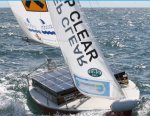The Austrian Society for Innovative Computer Sciences (INNOC) designed and constructed “ASV Roboat” will take aim at the current robotic sailing world record in July.
The sailboat will attempt to cover 150 nautical miles and undertake all the processes of sailing – from route planning to manoeuvring – without human intervention. If successful, the mission won’t just break the record; it will blow it away as the current world record stands at 78.9 nautical miles.
The ASV Roboat is 3.75m long and including batteries has an overall weight of 300 kg. An additional payload of up to 50 kg can be carried without impacting on sailing behaviour. It has sail area of 4.5 m2 and is equipped with solar panels providing up to 285 watts of power during optimal conditions. A direct methanol fuel cell delivering 65 watts is used as a backup energy source.
The rudder, sails, tacks and jibes are autonomously controlled by incoming data gathered by various on-board sensors such as GPS, compass and anemometer; with information being processed by an onboard PC running Linux. The Roboat has a three-stage communication system, combining WLAN, UMTS/GPRS and an IRIDIUM satellite communication link.
The upcoming journey isn’t just about breaking a record – during the voyage it will contribute to an important study of the endangered harbour porpoise in the Baltic Sea. Using an underwater microphone attached to the keel of the boat, recordings of marine mammal sounds will be made; giving scientists more data about migration routes and communication behaviour.
Beyond this mission, the INNOC team sees other applications for their technology.
“Because they are energy self-sufficient, in addition to marine biology, these solar energy powered robotic sailing boats can also be used for tsunami early warning systems, search operations, meteorological measurements and the recovery of oil spills,” says project manager Roland Stelzer.
Another unmanned ocean vehicle (UOV) utilising solar power that we’ve covered in the past is the WaveGlider.












































